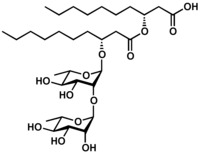
Photo from wikipedia
Phospholipase Cβ (PLCβ) enzymes hydrolyze phosphatidylinositol 4,5-bisphosphate to produce second messengers that regulate intracellular Ca2+, cell proliferation, and survival. Their activity is dependent upon interfacial activation that occurs upon localization… Click to show full abstract
Phospholipase Cβ (PLCβ) enzymes hydrolyze phosphatidylinositol 4,5-bisphosphate to produce second messengers that regulate intracellular Ca2+, cell proliferation, and survival. Their activity is dependent upon interfacial activation that occurs upon localization to cell membranes. However, the molecular basis for how these enzymes productively interact with the membrane is poorly understood. Herein, atomic force microscopy demonstrates that the ∼300-residue C-terminal domain promotes adsorption to monolayers and is required for spatial organization of the protein on the monolayer surface. PLCβ variants lacking this C-terminal domain display differences in their distribution on the surface. In addition, a previously identified autoinhibitory helix that binds to the PLCβ catalytic core negatively impacts membrane binding, providing an additional level of regulation for membrane adsorption. Lastly, defects in phosphatidylinositol 4,5-bisphosphate hydrolysis also alter monolayer adsorption, reflecting a role for the active site in this process. Together, these findings support a model in which multiple elements of PLCβ modulate adsorption, distribution, and catalysis at the cell membrane.
Journal Title: Biochemistry
Year Published: 2017
Link to full text (if available)
Share on Social Media: Sign Up to like & get
recommendations!